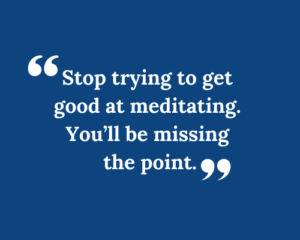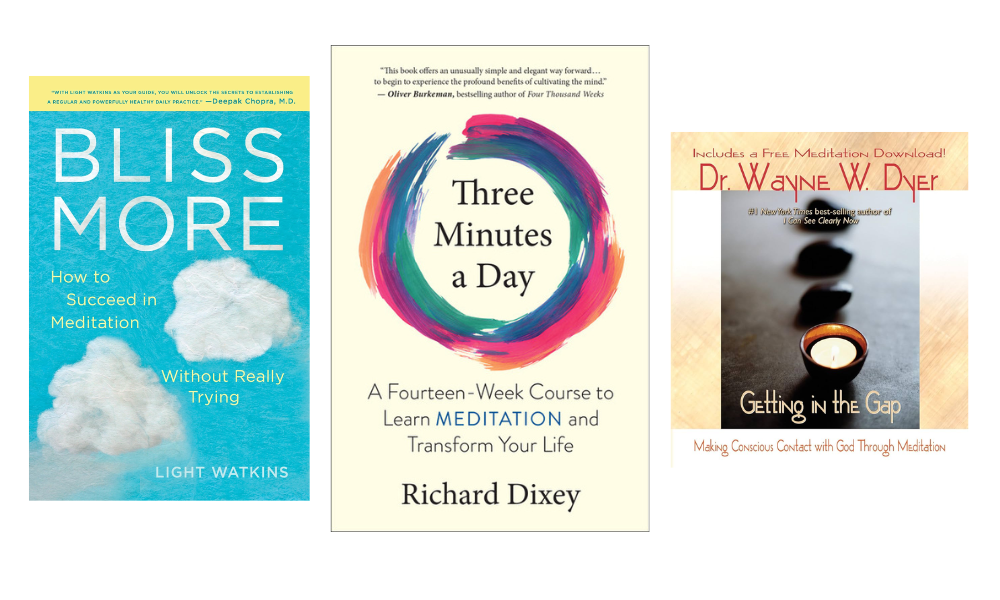It’s a new year, which means new resolutions for health and happiness. On January 1st, many people resolve to meditate daily, but by February, a lot of them have given up. I think this is because our approach to meditation is totally flawed. We think it’s something we’re supposed to do right or get good at. So when we can’t “do it right” or it doesn’t appear we’re getting good at it, we quit. Who wouldn’t abandon something we thought we would always fail at or something we think our brains are not designed for?
The key to having a helpful and stress-free, even enjoyable, meditation practice is to approach it merely as a means to an end. Here’s what I mean…
Meditation as Mental Weightlifting
Meditation is like weightlifting. We don’t lift weights to excel at the act itself but to strengthen our muscles for various life applications. Similarly, meditation develops our mental muscles, enabling us to create pauses between external events and our reactions.
 This practice enhances our ability to respond thoughtfully rather than react impulsively. Approaching meditation with this perspective shifts the focus from achieving a flawless session to appreciating the gradual development of mental strength. Stop trying to get good at meditating. You’ll be missing the point.
This practice enhances our ability to respond thoughtfully rather than react impulsively. Approaching meditation with this perspective shifts the focus from achieving a flawless session to appreciating the gradual development of mental strength. Stop trying to get good at meditating. You’ll be missing the point.
The Puppy Analogy: Embracing a Gentle Approach
Imagine your mind as a playful puppy during meditation. Naturally, the puppy wants to explore, mirroring how our thoughts tend to wander. Instead of expressing frustration, gently guide the puppy back to your lap each time it strays. This act symbolizes returning your focus to the present moment whenever distractions arise. Utilizing tools like mantras, breath counting, or guided meditations can serve as a ‘bone’ that you give your puppy to chew on. They give your mind something to do/focus on.
Wandering thoughts are natural and inevitable. Simply sit and practice guiding the mind. The mind will wander away and you’ll pick it back up again. Meditation is not about completely clearing the mind of thoughts. It’s about acknowledging and gently redirecting these thoughts. This the practice.
Of course, it’s okay to have days where the mind feels particularly active. It’s okay if this is how your mind is most days, or all days. There’s nothing wrong. Keep practicing with consistency and self-compassion, allowing it to integrate into daily life with ease. Drop the idea that you’re supposed to be doing it right. Let meditation simply be about doing it, regardless of what shows up.
Practical Tips for an Enjoyable Meditation Practice
To cultivate a sustainable meditation routine, consider the following:
- Create a Comfortable Environment: Use cushions, blankets, or soothing scents to make your meditation space inviting.
- Set Realistic Expectations: Begin with short sessions, gradually increasing the duration as comfort grows. Or don’t. A two-minute daily practice you cultivate over decades is much better than a 20-minute practice you can only do some times.
- Incorporate Enjoyable Elements: Listen to calming music or choose guided meditations that resonate with you.
- Practice Self-Compassion: Acknowledge that a wandering mind is natural; gently redirect your focus without judgment.
Recommended Reads to Enhance Your Practice
To deepen your understanding and practice of meditation, here are three insightful books:
Bliss More: How to Succeed in Meditation Without Really Trying
Authored by Light Watkins, this book demystifies meditation, presenting it as an accessible and enjoyable practice. Watkins introduces the E.A.S.Y. approach, making meditation less intimidating for beginners.
Three Minutes a Day: A Fourteen-Week Course to Learn Meditation and Transform Your Life
Richard Dixey offers a practical program that requires just three minutes daily. This structured course is designed to help individuals develop a consistent meditation habit, making it feasible even for those with busy schedules. Here my podcast interview with Richard here.
Getting in the Gap: Making Conscious Contact with God Through Meditation
Dr. Wayne W. Dyer explores the space between thoughts, referred to as the ‘gap,’ and provides techniques to connect with the divine through meditation. His insights cater to those seeking a spiritual dimension in their practice. This was the very first book I read about meditation and I’ve never forgotten it.
 Final Thoughts
Final Thoughts
Redefine meditation as a tool for building mental resilience rather than a skill to be perfected. Utilize supportive resources and add what you need to make your seat time feel good so you can develop a sustainable and fulfilling meditation practice that enriches every aspect of your life.